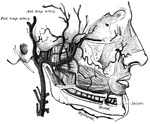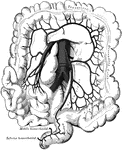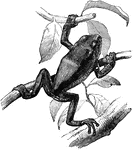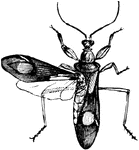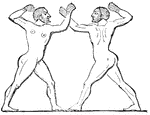
Boxing
"The Olympic games were of greater efficacy than the Amphictyonic Council in promoting the spirit of…

Oscillum
"A diminutive through osculum from os, meaning "a little face," was the term applied to faces or heads…
Abatis
"Abatis consisting of trees lying parallel to each other with the branches pointing in the general direction…

Slashing
"An abatis formed by felling trees toward the enemy, leaving the butt hanging to the stump, the branches…
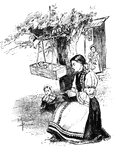
Russian Peasants
"There are trees here and there on each side of the roadway. Under one of them a woman is knitting,…

Mowgli's Brothers
Baloo instructs Mowgli concerning the monkeys. "But we do not notice them even when they throw nuts…

Gland
"Diagram to show the working parts of a gland. v and a are blood tubes with thin-walled branches around…
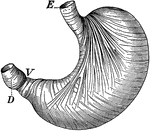
Stomach
"The stomach is a half-gallon sac, with an outer wall of muscle lined within by mucous membrane, made…

Sympathetic Nervous System
"Part of the sympathetic nervous system seen from in front, n, one of the two chief cords, t, i, and…
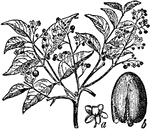
Mahogany
A large tree of the order meliaceae, common to tropical America, and noted for its close-grained and…

Tree Design
Sometimes called the tree of life. Always associated with religious belief. It symbolizes Divine power…
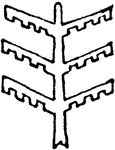
Tree Design
Sometimes called the tree of life. Always associated with religious belief. It symbolizes Divine power…
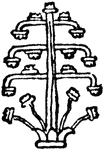
Tree Design
Sometimes called the tree of life. Always associated with religious belief. It symbolizes Divine power…
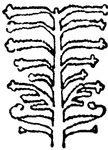
Tree Design
Sometimes called the tree of life. Always associated with religious belief. It symbolizes Divine power…
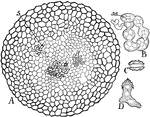
Ascocarp
This illustration shows further development of the ascocarp: A, sectional view, showing the branches,…
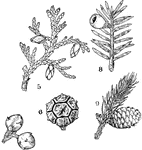
Pinales
This illustration shows some common examples of Pinales: 5, Thuja or arbor vitae. 6, Strobilus, of Chamaecyparis…

Bronchioles
This diagram shows the bronchial tubes, with clusters of cells. The bronchioles are the first airway…

Bud and Graft
This illustration shows a tree that has been both branch-budded and grafted. Buds inserted in August.…
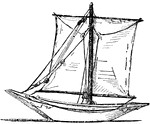
Doonga
A canoe made out of a single piece of wood and carrying a square sail, employed for navigating the marshes…
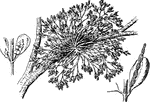
American Mistletoe
They are shrubby yellowish green parasites, generally with abundant short jointed branches, flat opposite…
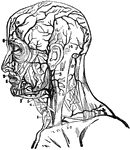
Facial Arteries
"1, primitive carotid artery dividing itself into carotid external and carotid internal; 3, occipital…

Thoracic Aorta
"The three branches from left to right are the unnamed ones. The primitive left carotid and the subclavian…

Siphon
"The action of the siphon illustrates the effect of atmospheric pressure. It is simply a bent tube having…
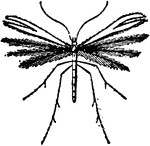
Plume Moth
"The insects of the group Pterophorina, are remarkable from the peculiar conformation of their wings.…

Plume Moth
"The insects of the group Pterophorina, are remarkable from the peculiar conformation of their wings.…

Single Eye
"This mode of propagation is performed by cutting the branches into short lengths, each containing one…
Pruning
"The nature of the cut itself in pruning is of more consequence, especially in the case of fruit trees,…

Pruning
"The nature of the cut itself in pruning is of more consequence, especially in the case of fruit trees,…
Pruning
"The nature of the cut itself in pruning is of more consequence, especially in the case of fruit trees,…
Pruning
"The nature of the cut itself in pruning is of more consequence, especially in the case of fruit trees,…
Pruning
"The nature of the cut itself in pruning is of more consequence, especially in the case of fruit trees,…
Pruning
"The nature of the cut itself in pruning is of more consequence, especially in the case of fruit trees,…

Montreuil Fan
"The Montreuil form of training. The principal feature is the suppression of the direct channel of the…

Dumontier's Fan
"The form of Dumoutier is merely a refinement on the Montreuil method. The formation of the tree commences…

Seymour's Fan
"Mr. Seymour's form approaches more nearly to the French method than any other practised in England,…

Astylus Subvividis
"Portion of the corallum of Astylus subvividis (one of the Stylasteridae), showing cyclosystems placed…

Restio
It is characterized by one celled anthers opening by a single chink, by two or three styles or branches…
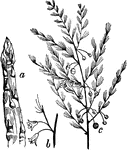
Asparagus
"Asparagus. a, a young shoot; b, flowers; c, the upper end of a stem, showing branches, leaves, and…
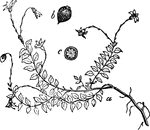
Cranberry
"Cranberry (Vaccinium palustris): a, part of stem and branches, with roots, leaves, and flowers; b,…
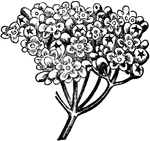
Cyme
"Cyme, in Botany, a common form of Centrifugal inflorescence, in which the rachis or floral axis disappears…

Facial Nerve
"(1) The facial nerve at its emergence from stylo-mastoid foramen; (2) temporal branches communicating…
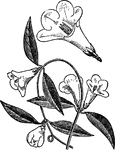
Gelsemium
"The plant known in America as the "Carolina jasmine" is not a true jasmine. other hardy species commonly…
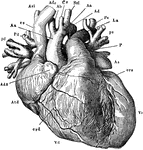
Heart
"The heart and the great blood-vessel attached to it, seen from the side towards the sternum. The left…
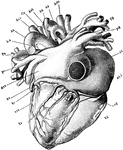
Heart
"The heart vied from its dorsal aspect. ci, inverior vena cava; Vc, coronary vein; Atd, right auricle;…

Elbow-Joint
"The superficial veins in front of the elbow-joint. B', tendon of biceps muscle; Bi, brachialis internus…
Conferva
The growing end of a branching Conferva (Cladophora glomerata), showing how, by a kind of budding growth,…

Wooly Aphid
Eriosoma Lanigera, or the Wooly Apple-Tree Blight. These insects appropriate for their generic name…

Agricultural and Mechanical College of Texas
The basis for funding for the college was established by the Morrill Act, passed by the US Congress…

Opposite-Leaved
Diagram of opposite-leaved plant with a cyne of three flowers; a the first flower, of the main…
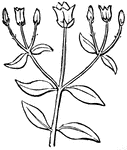
Opposite-Leaved
Diagram of opposite-leaved plant with a cyne of three flowers; a the first flower, of the main…



